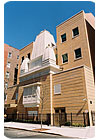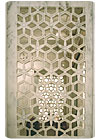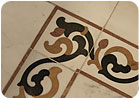
The exterior of the Jain Center of America in Elmhurst, NY, features window screens carved from Ambaji White marble. The material was sourced by Lotus Exim International Inc. of Englewood, NJ.
Staying true to the architecture and religious symbolism of temples in India ranked high in priority when designing the new Jain Center of America in Elmhurst, NY. And one key component of the temple design was using natural stone from India to develop a center with a welcoming and respectful environment where members can gather together and worship.
“The design goal for this project was to create a beautiful and lasting religious and community facility, which utilized traditional design elements from Indian religious structures,†said Project Architect Rashmi Sen of Sen Architects llp of New York, NY. “Most temples in India have a towering spire or 'shikhar' above the area where the deities are kept. These spires are often covered with elaborate stone carvings. This symbolic element is the main feature of the exterior of the building. Additionally, there are smaller internal spires above the sanctuary areas of the temples. Other traditional elements include the use of wall niches for deities, carved stone screens and statuary.â€

The intricately carved marble window screens were custom made for the temple by artisans at Trivedi Tectonics in Ahmedabad, India.
Throughout the four stories of the 20,000-square-foot building, natural stone was employed for the majority of interior areas, including the floor in public spaces as well as decorative stone wall paneling and trim.

Inside the temple, large stone statues - weighing an average of 5,000 pounds - symbolize traditional design elements of religious structures in India.
Additional stones such as Udaipur Green marble, Jaisalmer Yellow marble and Lakha Red granite - also quarried in India - were used as accent materials in the temple area. In other circulation and lobby areas, a harder and more durable stone, which can stand up to high traffic, was necessary. As a result, Imperial White granite with Black Galaxy granite accents was employed as flooring in these spaces.

“White marble that has been ornately carved is traditionally used in temples in India,†explained Project Architect Rashmi Sen. “This creates the atmosphere of serenity and introduces an ethereal grandeur to the place of worship. White Ambaji marble was the main stone used for this purpose in the religious temple areas.â€
Lotus Exim International Inc. of Englewood, NJ, was responsible for sourcing and inspecting the stone to ensure that the quality and installation of the product met the appropriate standards. The company managed the overall supervision of the project. All of the stone was quarried and fabricated by Trivedi Tectonics of Ahmedabad, India.
“We wanted to ensure that the materials used for this project passed the stringent inspection standards set by us, as the temple is an icon of worship not only for our generation, but the future generations that will continue to come here,†said Rajendra Kankariya, owner of Lotus Exim International Inc. “And, that is why we took extra care to monitor the material every step of the way.â€

Many of the wall panels were 5 x 4 feet - with the largest being 8 x 3 feet and 6 inches thick. An interlocking system that used stainless steel pieces to secure the heavy stone panels was implemented.
Installing the stone
“There were many challenging aspects to the project,†explained Sen. “One was coordinating all the religious requirements in the sanctuary areas, where no steel clips were used. The second was the size of some of the ornate stone pieces that had to be supported, especially above the main sanctuary.â€According to the architect, the installation team from Stone Logistics in New York did an excellent job. “Yanoush Mars, the owner, was personally involved in the installation. The team from India - Trivedi - also did a good job in marking the pieces and preparing detailed shop drawings. Therefore, the time spent on site supervising the installation of the stonework was not very extensive.â€
A total of five workers from Stone Logistics were involved with the installation. “The weight factor was the most challenging,†said Jaunus Mars of Stone Logistics. “The elevator was broken, and most of the pieces couldn't go through the windows, so we had to carry them up the steps.â€

According to the stone contractor, Jaunus Mars of Stone Logistics in New York, installing the thousands of decorative stone accent floor pieces was similar to putting a large puzzle together. Each of the pieces were marked on the back to assist in an easier installation.
The flooring throughout the temple is compromised of 16- x 16-inch tiles, which were mud set, accented by intricate medallions that consist of various-sized pieces. “It was like a huge puzzle,†said Mars. “Everything was fabricated in thousands of pieces. They had very good markings though.â€
Installing the stonework was completed in about six months, and the Jain Center of America opened in February 2005 with positive reviews. The temple and architects were awarded the “Excellence in Design Award†from the Queens Chamber of Commerce. “The reaction has been extremely positive,†said Sen. “The community is overjoyed to have a magnificent place to congregate for prayers and social events.â€
Jain Center of America
Elmhurst, NY
Architect:Sen Architects llp, New York, NYStone Installer:Stone Logistics, New York, NY
Stone Quarrier/Fabricator:Trivedi Tectonics, Ahmedabad, India
Stone Sourcer/Inspector:Lotus Exim International Inc., Englewood, NJ
